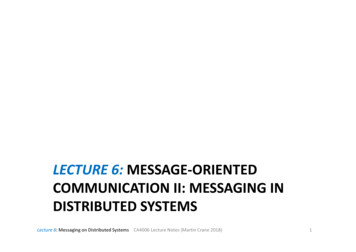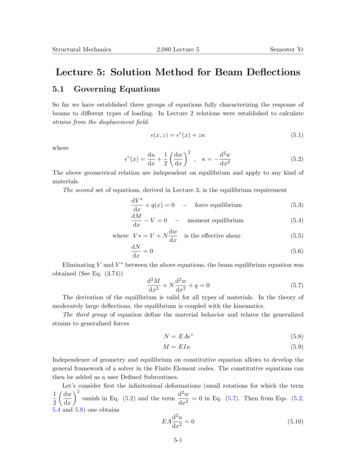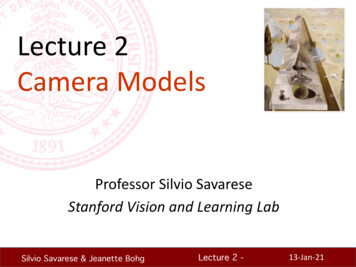
Transcription
Lecture-1An Overview of MicroprocessorThe first question that comes in one’s mind is "What is amicroprocessor?”. Let us start with a more familiar term computer. Adigital computer is an electronic machine capable of quicklyperforming a wide variety of tasks. They can be used to compile,correlate, sort, merge and store data as well as perform complexcalculations at much faster rate than human being by means ofstored instructions.A digital computer is different from a general purpose calculatorin a sense that digital computer is capable of operating according tothe instructions that are stored within the computer whereas acalculator must be given instructions on a step by step basis toperform calculations. By this definition a programmable calculator canbe considered a computer.Historically, digital computers have been categorized accordingto the size using the words large, medium, minicomputer andmicrocomputer. In the early years of development, the emphasis wason large and more powerful computers. Large and medium sizedcomputers were designed to solve complex scientific and engineeringproblems. In early stage of development these computers wereaccessible and affordable only to large corporations, big universitiesand government agencies. Later on, minicomputers were madeavailable for use in office, small collage, medium size businessorganization, small factory etc. As the technology has advanced fromSSI to VLSI & SLSI, the face of the computer has changed gradually
and it became possible to build the entire central processing unit(CPU) on a single-chip known as microprocessor.A control processing unit (CPU) with its related timing functionson a single chip known as microprocessor. A icesformsamicrocomputer.The microcomputer is making an impact on every activity ofmankind. It is being used in almost all control applications. Forexample analytical and scientific instruments, data communication,character recognition, musical instruments, household items, defenceequipments, medical equipments etc.Microcomputers or, in general, computers communicate andoperate in binary numbers ‘0’ and ‘1’ also known as bits. A bit is theabbreviation for the term binary digit. The bit size of a microprocessorrefers to the number of bit which can be processed simultaneously bythe arithmetic circuit of the microprocessor. A number of bits taken asa group in this manner is called word. For example, the firstcommercial microprocessor the Intel 4004 which was introduced in1971 is a 4-bit machine and is said to process a 4-bit word. A 4-bitword is commonly known as nibble and an 8-bit word is commonlyknown as byte. Intel 8085A is an 8-bit microprocessor whereas Intel8086 is a 16-bit microprocessor. It should be noted that a processorcan perform calculations involving more than its bit size but throughprogram and takes more time to complete the operation. Forexample, multi-byte data can be added byte by byte in 8085Aprocessor which is an 8-bit processor. The short word length requiresfew circuitry and interconnection in the CPU.
Microcomputers:In a very general sense, a microcomputer is best regarded as asystem incorporating a CPU and associated hardware whosepurpose is to manipulate data in some fashion. This is exactly whatany digital circuit designed using SSI’s and MSI’s does. Therefore,microcomputer should be regard as a general purpose logic device.In contrast to standard SSI’s and MSI’s where the manufacturerdecides what the device will do, with microcomputer it is the user whodecides what the device should do by asking it to execute a properset of instructions. A microcomputer, from this point of view is merelyan assembly of devices whose sole task is to ensure that theinstruction desired are indeed carried out properly and to allow themicroprocessor to communicate with the real world, i.e. the userenvironment. The power of the microcomputer lies in the fact that ifthe application changes, the same system can be used byappropriately modifying the instructions to be executed and, ifnecessary, some changes in the hardware. In contrast, a digit circuitdesigned using SSI’s and MSI’s for some application will need to becompletely redesigned if the application changes significantly.The objective of a microcomputer (μc) is to manipulate data in acertain fashion specified by the system designer. A typicalmicrocomputer achieves their objective by getting its CPU to executea number of instructions in the proper sequence. This sequence ofinstruction comprises the program that is executed by themicrocomputer. A microcomputer which does nothing other thanmanipulate data present within itself, will not be of much use to
anyone. In order to do something meaningful, data being manipulatedshould depend on inputs provided to the microprocessor by the user.Similarly,the data manipulations being carried out by themicroprocessor would be completely meaningless unless the resultsof these manipulations affect things outside the microcomputer itself.Therefore, the µc should provide outputs which in some way dependon its inputs, the way inputs and outputs are related is decided by theprogram that gets executed.Therefore, a microcomputer is an assembly of devices includinga CPU, which manipulate data depending on one or more inputs andaccording to a program, in order to generate one or more output.MicrocontrollersA µP does not have enough memory for program and datastorage, neither does it has any input and output devices. Thus whena µP is used to design a system, several other chips, such asmemory chips and input/output ports, are also used to make up acomplete microcomputer system. For many applications, these extrachips imply additional cost and increased size of the product and maynot be suitable for the application. For example, when used inside atoy, a designer would like to minimize the size and cost of theelectronic equipment inside the toy. Therefore, in such applications amicrocontroller is used more often than a microprocessor.A microcontroller is a chip consisting of a microprocessor,memory and input/output ports.
Evolution of the MicroprocessorsThe first µP was introduced in 1971 by Intel Corporation. Thiswas the Intel 4004, a processor on a single chip. It had the capabilityof performing simple arithmetic and logical operations. For example,addition, subtraction, comparison, logical AND and OR operations. Italso had a control unit which could perform various control functionslike fetching an instruction from the memory, decoding it andgenerating control signals to execute it. It was a 4 bit µP operating on4 bits of data at a time. The processor was the central component inthe chip set, which was called the MCS-4. The other components inthe set were a 4001 ROM, 4002 ROM and a 4003 shift register.Shortly after the 4004 appeared in the commercial marketplace, three other general purpose microprocessors were introduced.These devices were the Rockwell International 4-bit PPS-4, the Intel8-bit 8008 and the National Semiconductor 16-bit IMP-16. Othercompanies had also contributed in the development of µP.The first 8 bit µP, which would perform arithmetic and logicoperations on 8 bit words, was introduced in 1973, by Intel. This was8008 that was followed by an improved version- the 8080 from thesame company. The µPs introduced between 1971and 1972 werethe first generation systems. They were designed using the PMOStechnology. This technology provided low cost, slow speed and lowoutput currents and was compatible with TTL.After 1973, the second generation µPs such as Motorola 6800and 6809, Intel 8085 and Zilog Z80 evolved. These µPs werefabricated using NMOS technology. The NMOS process offeredfaster speed and higher density than PMOS and was TTL compatible.
The distinction between the 1st & 2nd generation devices was primarilythe use of new a semiconductor technology to fabricate the chips.This new technology resulted in a significant increase in instructionexecution speed & higher chip densities.After 1978, the 3rd generation microprocessors were introduced.Typical µPs were Intel 8086/ 80186/ 80286 and Motorola 68000/68010. These µPs were designed using HMOS technology. HMOSprovides the following advantages over NMOS.1) Speed power produced (SSP) of HMOS is 4 times better thanthat of NMOS. That is for NMOS, SSP is 4 picojoules (PJ) andfor HMOS, SSP is 1 picojoules (PJ).Speed power product speed * power nanoseconds * mill watt picojoules2) Circuit densities provided by HMOS are approximately twicethose of NMOS. That is for NMOS, it is 4128 µm2/gate and forHMOS it is 1052.5 µm2/gate.Later, Intel introduced a high speed version of the 8085A called8085AH using HMOS technology to fabricate the 8085A.The third generation introduced in 1978 was typically separatedby the Intel 8086 iAPX8086, iAPX80186, iAPX80286, Zilog 8000, andthe Motorola 68000 which are 16- bit µPs with minicomputer likeperformance. One of the most popular 16-bit µP introduced by Intelwas 8088. The 8088 has the same introduction set as the 8086.However, it has only an 8 bit data bus. The 8088 is the µP used in the
IBM PC and its clones. A precursor to these microprocessors was the16-bit Texas Instruments 9900 microprocessor introduced in 1976.Table: Evaluation of major µP characteristics from Intel400480088085A808680386Year ofIntroductionData TechnologyPMOSPMOSNMOSHMOSCHMOSWord sizedata/ instr.AddresscapacityClockkHz/phaseAddition 28000/216000/210.8 µs20 µs1.3 µs0.375 µs 0.125 µs1/61/61/81/87x14RWMRWMRWMALU/General 1/16Purpose Reg.Stack size3x12Voltages15-10,5* -9.5v 5V 5V 5VPackage 3135Transistors2,3002,0006,20029,0002,75,000Chip size(mil)117x159 125x170164x222225x230 390x390In 1980, the fourth generation µPs were evolved. Intelintroduced the first commercial 32 bit microprocessor, Intel 432.Since 1985, more 32-bit µPs have been introduced. These include
Intel iAPX80386, Intel 80486, Motorola MC68020/68030/68040,National semiconductor NS 32032. These processors were fabricatedusing the low power version of HMOS technology called HCMOS,and they include an on-chip RAM called the cache memory to speedup program execution. The characteristics for few microprocessorsintroduced by Intel are given in the Table.This shows that power of microprocessors has increasedtremendously with advancement in integrated circuit technology µprocessor systems architecture. Very large scale integration,VLSI, allows extremely complex system consisting of as many as amillion of transistors on a single chip to be realized.The performance offered by a 32-bit µP is more comparable tothat of supercomputers such as VAX 11. Extensive research is beingcarried out for implementation of more on chip functions and forimprovement of the speed of the memory and I/O devices.Applications of Microprocessors:The application of microprocessors is increasing day by day.Some of the applications are:1) Analytical scientific instruments2) Smart terminals3) Stacker crane controls4) Conveyor controls5) Word processor6) Point of scale systems7) Standalone electronics cash system8) Electronic games
9) Vending and dispensing machines10) Market scales11) Traffic light controls12) Home heating and lighting controls13) Security & fire alarm system14) Home appliances15) Computer aided instruction16) On line control of lab instrumentation17) Desktop computers18) Check processor19) Payroll system20) Inventory control21) Automatic type setting22) Compact business machines23) Medical instrumentation24) Automobile diagnostics25) Data communication processing26) Optical character recognition27) I/O terminal for computers.
1971 is a 4-bit machine and is said to process a 4-bit word. A 4-bit word is commonly known as nibble and an 8-bit word is commonly known as byte. Intel 8085A is an 8-bit microprocessor whereas Intel 8086 is a 16-bit microprocessor. It should be noted that a processor can perform calculations involving more than its bit size but through











